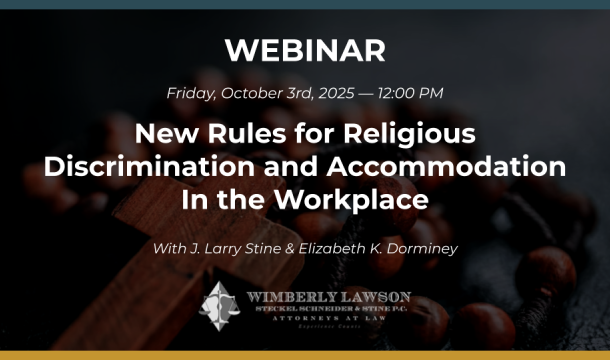Trump’s Executive Order Redefining Sex Creates Immediate Issues for Employers
President Trump’s Executive Order issued the first day in office requires federal agencies, including the Equal Employment Opportunity Commission (EEOC), to change any documents, regulations or guidance to reflect that male and female are the only two sexes. It particularly challenges the Biden Administration’s recent workplace harassment guidance expanding the scope of LBGTQ+ protections under Title VII of the Civil Rights Act. The EEOC Acting Chair, Andrea Lucas, appointed by President Trump, indicated she would propose a recission of that guidance when she has a quorum of three Commissioners to vote on it. Among other things, the guidance states that using a name or pronoun inconsistent with an employee’s known gender identity or denying them access to a bathroom consistent with their gender identity constituted sex-based harassment under Title VII. In the guidance, the EEOC cited the U.S. Supreme Court decision in Bostock v. Clayton County, which held that Title VII’s prohibition on sex discrimination extended to bias based on sexual orientation and gender identity. Lucas indicated, however, that the Supreme Court decision stated that it did not purport to address bathrooms, locker rooms, or anything else of the kind. Lucas also stated that the agency is already dropping litigation that cites protections outlined in the guidance. Lucas released a statement that: “It is neither harassment nor discrimination for a business to draw distinctions between the sexes in providing single-sex bathrooms or other similar facilities which implicate the significant privacy and safety interests.”
Editor’s Note: At least one federal judge has ruled that the Biden Administration illegally broadened Title VII’s scope by saying that Bostock covers workplace policies on bathrooms, dress codes, and locker rooms. Regardless of the executive order and/or the EEOC’s guidance, employers are still obligated to follow the statutory requirements under Title VII. That means that cases can still be litigated on legal theories supporting the positions set forth in the current guidance, and many employers are rightly unsure of where they stand. The changes do not immediately affect coverage under federal healthcare plans, but the Administration’s position on transgender people suggest there may be efforts to curtail gender-affirming healthcare coverage, a move likely to trigger another legal battle. There is also the difficulty in identifying a person’s sex, as some areas allow birth certificates to be altered to reflect gender identity. It is estimated that there are over 1 million persons in the U.S. of a transexual nature.
The situation suggests that employers need to be careful in navigating this legal landscape. Under current EEOC guidance, yet to be revised, employers are obligated to allow persons to use bathrooms of the gender they identify with. Under the executive order, and likely future EEOC guidance, there is no such right and presumably persons using a bathroom could claim some type of harassment if the employer allows persons of another biological sex to use the same bathroom.
What is an employer to do? In terms of the bathroom issue, a reasonable approach would seem to be to allow such persons to use a sex-neutral bathroom, designated for that purpose. While the current EEOC guidance does not recognize this approach, in light of the legal confusion, it would seem to be a reasonable measure. That still leaves the issue of whether an employer should require employees to call transgender workers using the transgender pronouns, an issue that will probably ultimately be resolved by an interpretation of Title VII rather by the executive order.
Similarly, lawyers may wonder about the terminology in their equal employment policies and the like, recognizing protections for transgender persons. The Executive Order attempts to remove the protections of transgender persons under equal employment laws, but the Executive Order does not per se limit an employer’s right to provide additional protections beyond those covered by the equal employment laws. Thus, an employer is likely to be able to maintain such policies presently, with the exception of the bathroom issue discussed above.
This article is part of our March 2025 Newsletter.
View newsletter online
Download the newsletter as a PDF
Related Content
Get Email Updates

Trump Nominates Appointments to NLRB and EEOC but Policy Changes Likely to Be Delayed

DOL Launches Self-Audit Programs Designed to Help Employers Improve Compliance

DOL Must Release EEO-1 Reports to the Public under Open Records Laws

Current Advice on Active-Shooter Situations

New Policy for Federal Workers and Religious Expressions
